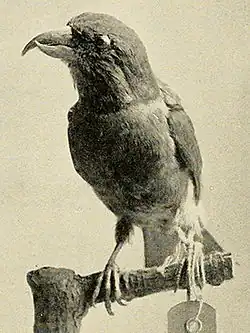Newfoundland crossbill
| Newfoundland crossbill | |
|---|---|

| |
| Mounted specimen | |
| Scientific classification | |
| Kingdom: | Animalia |
| Phylum: | Chordata |
| Class: | Aves |
| Order: | Passeriformes |
| Family: | Fringillidae |
| Subfamily: | Carduelinae |
| Genus: | Loxia |
| Species: | |
| Subspecies: | L. c. percna
|
| Trinomial name | |
| Loxia curvirostra percna Bent, 1834
| |
The Newfoundland red crossbill (Loxia curvirostra percna) is a subspecies of the red crossbill found on and believed to be endemic to the island of Newfoundland, and recently also discovered on Anticosti Island in the Gulf of Saint Lawrence, administratively part of Quebec.[1] Its population on Newfoundland is greatly reduced (and had even been considered extinct by some[2]), due to competition from introduced American red squirrels Tamiasciurus hudsonicus.[3]
It is very similar to other North American subspecies of red crossbill, differing primarily in its stouter bill, 9–10 mm thick at the base, compared to 8 mm for other populations in Canada,[1] and also marginally larger overall.[3] Its calls are also distinct, given the designation 'vocal type 8' to distinguish it from other subspecies.[1][3] The plumage is very similar to other subspecies, though on average slightly darker and duskier.[3]
The taxonomy of the bird has been questioned.[4]
References
- ^ a b c Tremblay, Junior A.; Robert, Michel; Hynes, Douglas P.; Young, Matthew A.; Drolet, Bruno (2018). "Range extension of the threatened Red Crossbill (Loxia curvirostra percna) in Canada: new insights from Anticosti Island, Québec" (PDF). Avian Conservation and Ecology. 13 (1) art10. doi:10.5751/ACE-01175-130110. ISSN 1712-6568. Retrieved 2025-07-21.
- ^ "Diversifying coevolution between crossbills and Black Spruce on Newfoundland" (PDF). Retrieved 2025-07-21.
- ^ a b c d Canada, Climate Change (2016-10-28). "Red crossbill (percna subspecies, Loxia curvirostra percna): COSEWIC assessment and status report 2016". Canada.ca. Retrieved 2025-07-21.
- ^ "Ours to Save: The distribution, status and conservation needs of Canada's endemic species" (PDF).